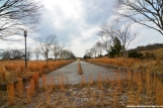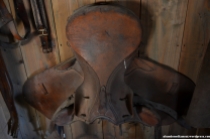When you think of Japan which other country comes to mind?
Probably Korea since it’s a neighboring country and both countries share an inglorious common history. China, of course, a major influence for centuries – from city planning to food. Most likely the United States as no other country had more impact on Japan in the past 70 years. Maybe Germany due to 150 years of more or less intense friendship and a similar post-war history.
Japan and New Zealand? A rather odd combination. Surprisingly *Michael* and I visited not only one, but two New Zealand themed amusement parks while on a *road trip in southern Honshu*. A couple of weeks ago I wrote about the *Hiroshima New Zealand Farm*, a closed but not abandoned theme park in Hiroshima prefecture. This time I’ll present you the clearly abandoned Yamaguchi New Zealand Village – same concept, same company, but without the shadow of a doubt a “lost place”; BTW: I really dislike the term Lost Place, which is used for urban exploration locations in Germany – not as bad “Handy”, which is used for mobile phones (!), but nevertheless a term that makes me cringe.
Arriving at the huge deserted parking lot of the New Zealand Village, it was pretty clear that we wouldn’t run into gardeners or other caretakers. The wooden handrail leading up to the entrance area was getting brittle and all kinds of plants grew without any attempt to tame them. Opened in July of 1990 after spending 1.8 billion Yen (currently about 16.5 million Euros or 21.7 million Dollars) the park’s attendance figures peaked in 1991 at 428.000 – in the following years the numbers dropped to about one third of that per annum before Farm Co. Ltd. put an end to it in 2005 by closing the park. Initially the 30 ha (300,000 m2) large New Zealand Village was put on hiatus for up to three years with the intent of re-opening it again one day, but that never happened. I don’t know if somebody took care of it for a while like they do at the New Zealand Farm (which is in its fourth year of closing), but nowadays the New Zealand Village is clearly abandoned…
(Just for comparison: *Nara Dreamland* peaked at 1.6 million visitors a year and closed when the number was as low as 400.000 – Universal Studios Japan in Osaka welcomes about 8 million guests a year.)
Exploring the New Zealand Village couldn’t have been more relaxed. Located in the middle of nowhere Michael and I enjoyed a wonderful sunny day on the copious premises.
The entrance area was dominated by a gift shop called カンタベリー (Canterbury), vandalized, but still stocked with quite a few examples of fake food Japan is so famous for – in this case all kinds of sweets. We found replicas of mini cakes, both Western and Japanese (mochi), all made of plastic and therefore still nice to look at.
In close proximity was the Jersey Factory that produced and sold homemade bronzer… sorry… handmade butter! And pretty much next to this place with a name that has no connection to New Zealand was a huge building that had New Zealand all over the place: Restaurant Rotorua, Newzealand Farm, Kiwi Country. Why give it one name when you can give it three? Or four, since all to the left it said “Main Bazaar”.
This food dominated commercial zone of the New Zealand Village, which overall had way less of a village feeling than the New Zealand Farm, was followed by the wide, open landscape I knew from other versions of the nature themed parks. And I loved it! I usually don’t feel very comfortable in abandoned buildings, but open areas like mining towns and amusement parks I really enjoy (if they are really abandoned), especially on sunny spring days!
What made the New Zealand Village in Yamaguchi different from those in Hiroshima and Shikoku was the variety of strange pedal-powered vehicles. Cars, bikes and really unique constructions – they were scattered all over the park, a plethora of rental… thingies. I took photos of many of them and maybe one day in the future I will publish a special picture set about them.
Another thing that made this installment of the New Zealand parks special (but not in a good way!) was the already mentioned presence of vandalism. It wasn’t “ZOMGWTFBBQ!?” bad, but since vandalism is always uncalled for it was nevertheless sad to see. Call me old-fashioned and naïve, but I like my abandoned places easy to access and naturally decayed. Luckily the amount of vandalism decreased the further we got away from the entrance, so by the time we reached the stables and Sheep House with its museum of 19th century farm equipment and a couple of taxidermy items in the making, vandalism was nothing but a bad memory.
What really bugged me about exploring the Yamaguchi New Zealand Village was the time pressure. Like I already mentioned, this was part of a road trip to the south of Honshu and the schedule was kind of tight. A place like this deserves a whole day of exploring and taking pictures, probably with some hours after sunset for some special photos – a luxury not available to us. So when Michael and I left after 3 hours (which is generous for most places – *Sekigahara Menard Land* I left after about 20 minutes…) it was with a bittersweet aftertaste, amplified by a bunch of beatniks who entered the parking lots just before we left. Us driving away was accompanied by the sound of burnouts in the distance…
(If you don’t want to miss the latest article you can *like Abandoned Kansai on Facebook* – and of course there is the *video channel on Youtube*…)
Addendum 2014-07-11: According to a friend of mine all the buildings have been demolished – R.I.P.!
















I worked on this park in 2000, I perforned the sheep shows. So sad to see this. I wonder what happened to the livestock on the property.
What were those sheep shows like? Races or more like presentations?
They boarded up all buildings shortly after I visited the Yamaguchi NZV, so the photo and video material of this article is actually quite rare.
I worked at this place in 1993 and left after 2 months in utter disgust with the way the animals were treated. I’m glad this place shut down, I did experience a typhoon while there which was pretty exciting!
I’m sorry to hear about the animals, but I can imagine the typhoon being exciting – those buildings there didn’t look like they were made to withstand forces like that!
Is that Allister Simpson from Dunedin? Isaac from Christchurch here, I think I worked in the restaurant the same time you were there? Kelly worked in the souvenir shop downstairs. I ended staying the whole year – at one stage I was the lone Kiwi in that crazy dorm (some of the staff lived on site)! Remembering working through Golden Week, man that was busy – the place would be chockas. They also used to have duck racing and made their own ice-cream. Families used to flock to it, though always thought it was funny that they painted them Green and Gold, Aussie colours.
Florian, there was a sheep show exhibition and a loop for horses to go around for paid rides. The cows were always ties up – one got loose one day (because it was so skinny) and tried to make a run for it but couldn’t walk as it legs couldn’t function. The majority of the horses were kept in concrete cells, a couple would bite people if they put their fingers through. I let the management know what I thought of their park and walked out.
That sounds absolutely horrible!
I remember the concrete stables and I wondered what they looked like when the park was still operative – most likely not much different from what you just told me…
Respect to your integrity, most foreigners in Japan most likely would have gone along with it for the “privilege” of living in Japan.
Thank you for making this video it has brought back a lot of memories for me. I used to live in the apartments above playland fast food starting at 5.19 in you video. I used to walk around this park every day on my way up to the restarant and bbq house where I worked from March to November 1999. I feel sorry for everyone that used to work there, I sometimes think about this park and now I know what happened to it. Weird how they left a lot of useful stuff there. Again thank you so much, awesome.
You are welcome! Weeks after my visit the whole place was boarded up. Now it’s impossible to enter the buildings, including the museum and the room with the taxidermy horse…
G’day Matt, hope you’ll remember me Shaun from Okayama 1999, we made some memories over there 🙂 get in touch mate if this gets to you, love to talk.
Shaun how’s it going? Yeah good times. Just saw this randomly. mateo1977@gmail.com is my email.
Matt and Shaun!! That was a crazy year. So many great memories. Amy from Hiroshima Village 😊
That is terribly sad to hear. I worked at yamaguchi nz village in 1991 for 12 months when it was a vibrant happy place. I always wondered if it would last. I went back to visit in 2005 when it was very quiet but well maintained. Very sad to see it in the current state
The Yamaguchi one was probably in worst condition since it is quite remote. They bolted it up just weeks after I went there, so there is hope that it will be turned into a nice place again one day.
People who worked at New Zealand Villages usually report bout the mistreatment of animals. What was your impression?
I recently bought a pottery drinking mug at a flea market. On it is written NZ (onwards)1947 Yamaguchi – Japan. This pre-dates the opening of the theme park, so what is it? any ideas?
Hmm… I have no idea. Maybe NZ are the artist’s initials?
It probably refers to New Zealand’s military who were part of the British Commonwealth Occupation force after WWII. They were based in Yamaguchi.
https://en.m.wikipedia.org/wiki/J_Force
Thanks for that link Sarah, well another few years have passed and I stumbled onto this website again. Interesting about the JForce, my Grandad was in that, and turns out in the same part of Japan I was in 50 years later in 1999.
My wife and I who are both kiwis met in this village in 1995 right in front of the stables. We used to rollerblade all around the paths and even down the Astro turf slope. Got some serious grazes from it. We now have four children aged 13 to 19 and we showed them this today. It is really quite emotional watching the videos. We live in Rotorua NZ. Thank you for posting this.